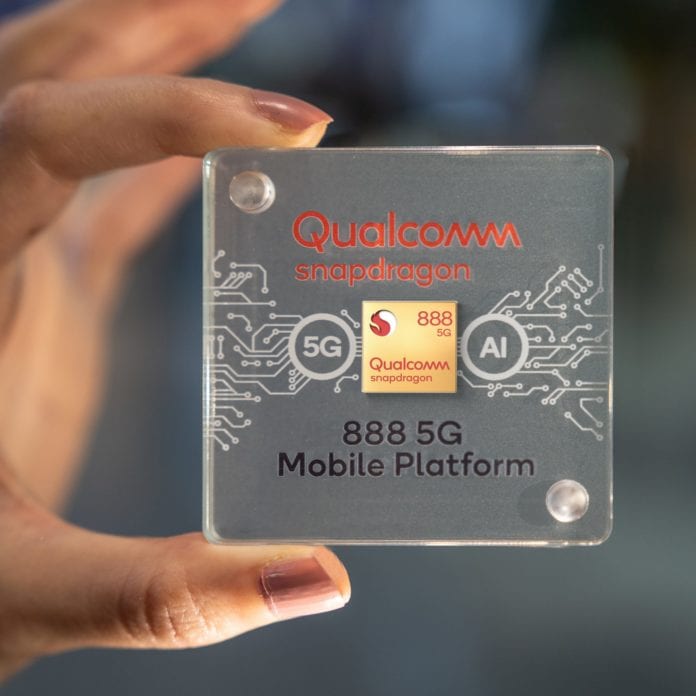Snapdragon 888 ready for global 5G with support for sub-6 GHz, mmWave, non-standalone, standalone, 5G carrier aggregation, Dynamic Spectrum Sharing
In lieu(au) of hosting its annual Snapdragon Tech Summit in Maui, Qualcomm today took the event virtual, unveiling its upcoming premium-tier Snapdragon 888 5G Mobile Platform to a global audience and looking to the future of 5G with partners, including Verizon, NTT DoCoMo, Sony Mobile Communications, OnePlus and more.
Preceded by the Snapdragon 865, 855 and 845 mobile platforms, the 888 breaks with the naming convention—8 is a lucky number in China and is associated with fortune and prosperity—and will bring significant performance improvements to 2021 Android-based flagship devices as 5G networks continue to rapidly ramp around the world.
Snapdragon 888 uses the third-generation X60 5G modem with support for sub-6 GHz, millimeter wave, the non-standalone and standalone modes of 5G New Radio, 5G carrier aggregation and Dynamic Spectrum Sharing, which allows 4G and 5G traffic to share the same spectrum at the same time. DSS is seen as a key technology for 5G coverage and for transitioning from NSA to SA. Full Snapdragon 888 performance details haven’t been made public just yet but the latest platform can aggregate sub-6 GHz and millimeter wave frequencies as well as FDD and TDD bands.
The latest mobile platform also features Qualcomm’s sixth-generation AI Engine which can push 26 tera operations per second. That’s coupled with the second-generation Qualcomm Sensing Hub for “always-on AI processing for intuitive, intelligent features.” Another key upgrade comes with the Qualcomm Spectra ISP which supports photo/video capture at 2.7 gigapixels per second, 35% faster than its predecessor.
Qualcomm Incorporated President Cristiano Amon described 5G as the connectivity medium accelerating a shift to high-power cloud storage and services. “Premium 5G devices provide the platform for innovation,” he said in his keynote presentation. “All of this takes a relentless focus on innovation. As the world’s leading wireless technology innovator, we’re delivering the technologies that redefine premium experiences.”
Amon was virtually joined by Verizon Chief Product Officer Nicki Palmer who discussed the operators millimeter wave 5G deployments, which is slated to reach 60 markets by year end as well as NFL and NHL venues and six U.S. airports. “And, of course, we don’t stop there. We’ll just continue to build,” Palmer said. In October Verizon augmented its millimeter wave 5G with nationwide coverage using DSS with its low-band LTE network.
In 2021 Palmer said Verizon would make the move from non-standalone to standalone 5G and begin to use network slicing wherein logical, virtual partitions are delivered across a network in support of specific types of traffic like cloud gaming or for individual enterprises in need of specially-tuned service level agreements. Mobile edge computing is also part and parcel of network slicing and Verizon is working on that with partners AWS and Microsoft. She called out “in the wild” 5G network speeds of 4 Gbps, lab speeds of 5 Gbps, and the role of multi-channel carrier aggregation “on the road to 10 Gbps.”
“5G is the general purpose technology that will power the Fourth Industrial Revolution,” Palmer said. “It sounds very dramatic but when you think about the transformational capabilities of this new wireless technologies and you couple it with all the other advances in computing…all these things come together and produce some amazing things.” In terms of Snapdragon 888 to coming to commercial devices next year, Palmer said, “I think what we’ll see in 2021 and beyond is these solutions starting to hit consumers, hit businesses, and start solving their problems.”
Among the device OEMs planning 888-based devices are ASUS, OnePlus, Miezu, Nubia, Motorola, Sharp, LG, Oppo, realme and ZTE. As PCMag Lead Analyst Sascha Segan points out in a tweet, “Qualcomm shows logos of a whole bunch of partners developing phones with the Snapdragon 888…all but two are Chinese. So that ‘888, lucky in China’ thing is important!”
Qualcomm projects between 450 million and 550 million 5G smartphones will ship next year with that number jumping to more than 750 million in 2022.

